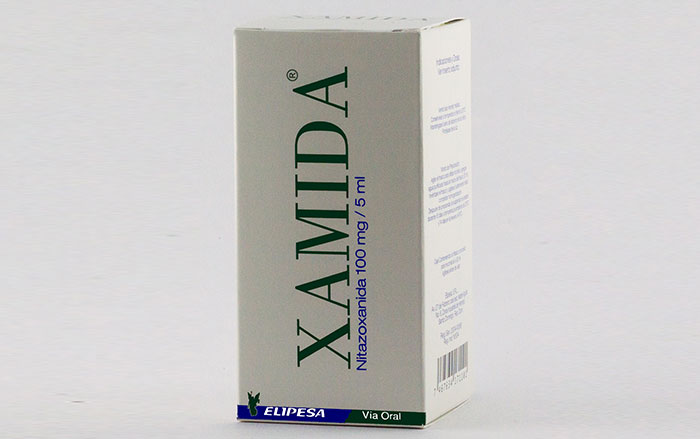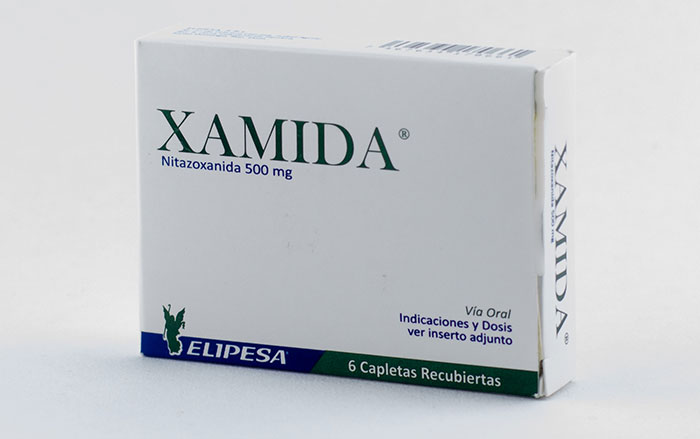[vc_row inner_container=»true» bg_color=»#ffffff» style=»margin-bottom:0px; padding-bottom:0px;»][vc_column alignment=»left» width=»1/2″]
Xamida
 [/vc_column][vc_column width=»1/2″]
[/vc_column][vc_column width=»1/2″] [/vc_column][/vc_row][vc_row inner_container=»true» bg_color=»#ffffff» style=»margin-top:0px; margin-bottom:0px;»][vc_column width=»1/1″]
[/vc_column][/vc_row][vc_row inner_container=»true» bg_color=»#ffffff» style=»margin-top:0px; margin-bottom:0px;»][vc_column width=»1/1″]Properties
Xamida contains Nitazoxanide, a broad-spectrum antiparasitic agent, with greater efficacy and less toxicity than its predecessors.
Indications
Xamida is an effective antiprotozoal to treat acute intestinal amebiasis or amoebic dysentery caused by Entamoeba histolytica. Effective anthelmintic against nematodes, cestodes and trematodes, and indicated in the treatment of Enterobius vermicularis, Ascaris lumbricoides and Strongyloides stercolaris, American Necator, Ancylostoma duodenale, Trichuris trichiura, Taenía saginata, Taenia solium, Hymenolepis and Fasciola. It is also indicated in the treatment of giardiasis due to Giardia lamblia and symptomatic trichomoniasis, in women and men, with confirmed presence of Trichomona vaginalis in the laboratory. Asymptomatic trichomoniasis, when the organism is associated with endocervicitis, cervicitis, and cervical erosions. In the asymptomatic sexual partner, since vaginal trichomoniasis is considered a sexually transmitted disease, the sexual partner must be treated simultaneously.
Mechanism of action
Nitazoxanide acts as an anthelmintic, interfering with the parasite’s glucose metabolism, thus creating a depletion of glycogen and lactic acidosis. As an antiprotozoal, it acts because its nitro group is reduced, which attacks the DNA of the parasite, resulting in an inhibition of the synthesis of parasitic nucleic acids and leading to the formation of cytotoxic products and the destruction of the protozoan, without injuring the human cell.
[/vc_column][/vc_row][vc_row inner_container=»true» bg_color=»#ffffff» style=»margin-top:0px; margin-bottom:0px;»][vc_column width=»1/2″]
Pharmacokinetics and pharmacodynamics
Absorption: Nitazoxanide is rapidly absorbed from the gastrointestinal tract. An absorption of approximately 48% is obtained, with peak plasma concentrations of 20.9 (ug / ml at the time of the post dose (1.87 ug / ml after 12 hours)). It is rapidly metabolized by oxidation into its corresponding deacetylated derivative.
Excretion: Excretion is mainly through the faeces; however, the fraction that is absorbed is rapidly metabolized and its active metabolite, desacetylnitazoxanide, exhibits activity for the extraintestinal clinical forms of parasitosis. This metabolite is completely eliminated in the urine within 24 hours of the dose.
Drug interactions
The use of nitazoxanide with coumarins and warfarin may increase the plasma levels of the latter, lengthening the prothrombin time.
Side effects
The adverse effects are slight and are located at the gastrointestinal level. Occasionally they appear, the most frequent being nausea, sometimes accompanied by headaches, anorexia, and less frequently vomiting, epigastric discomfort, colic-type abdominal pain, vertigo, diarrhea and weakness. Exceptionally, rash and asymptomatic yellowish discoloration have been reported in the urine, and even ejaculate and sclerotic, without pathological value, which reverts spontaneously at the end of treatment.
Posology
Adults
In giardiasis, amebiasis, trichomoniasis, ascariasis, whipworms, hookworms, oxyuriasis: A complete dose of 500mg 2 times a day for 3 days. Taeniasis: A single dose of 45mg / kg of weight in a single dose. Fasciolasis: A caplet of 500 mg 2 times a day for 7 days.
It is recommended to ingest the caplets with food.
Children between 2 and 8 years old:
Amebiasis / cysts and trophozoites, giardiasis, helminths: 5ml of suspension 2 times a day (morning and night) for 3 consecutive days.
Fasciolasis: 5ml of suspension 2 times a day for 7 consecutive days.
Children from 8 to 12 years old:
10 ml of suspension 2 times a day for 3 consecutive days.
The dosage for children is adjusted according to age and weight; but the recommended is 7.5mg / kg of weight every 12 hours for 3 days in a row.
[/vc_column][vc_column width=»1/2″ style=»background-color:#f4f4f4; height:100%; padding-left:10px; padding-right:10px;»]
Composition
Xamida Suspension
Each 5ml contain:
Nitazoxanide 100mg
C.S.P. excipients 5ml
Xamida Caplets
Each coated caplet contains:
Nitazoxanide 500mg
C.S.P. excipients
Administration route
Oral
Presentation
Box containing blister with 6 coated caplets.
Box containing bottle with powder to reconstitute at 30 ml and 60 ml.
Storage recommendation
Store below 30 °C. Protect from light and moisture.
Contraindications
Xamida is contraindicated in patients with a history of hypersensitivity to the active substance or to any of the components of the product.
The use of nitazoxanide during pregnancy and lactation, when strictly necessary, is under the decision and responsibility of the doctor. It is not recommended for use in children under 2 years of age.
[/vc_column][/vc_row]
